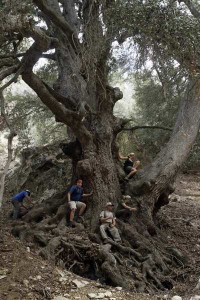Yucaipa-area oak towers over the competition
Giant canyon live oak measures 499 inches around and 97 feet high, with a 98-foot canopy spread. But is it the biggest oak in the United States?
Source of this article: The Los Angeles Times, September 3, 2012
After a hellish hike in the wilderness above Yucaipa in the San Bernardino Mountains on a recent weekday, seven naturalists with cameras, measuring tape and lasers entered the shade of a gargantuan oak tree and looked up at its gnarled branches, their eyes alive with anticipation.

AGE UNKNOWN – It is impossible to guess how many centuries the tree has stood on the steep, rocky hillside overlooking a narrow stream-fed canyon thick with incense cedars, canyon maples and bracken fern.
The Wildlands Conservancy members had come to take precise measurements of what they believed could be the largest canyon live oak in existence and, perhaps, the largest oak of any species in the country.
“Hell of a tree,” whispered Geena Burgess.
April Sall spread her arms wide and simply smiled.
Evan Welsh, who discovered the tree in early July, started unpacking an assortment of surveyor’s equipment.
Last month, Welsh took initial measurements that suggested the tree was eligible for certification by the nonprofit American Forests organization’s National Big Tree Program as the country’s top “champion” oak.
Nominating a tree with record-breaking potential requires three measurements: trunk circumference in inches; height in feet and average crown spread in feet. Total points for a contender are determined through this calculation: circumference plus height plus 1/4 the average crown spread.
With 628 points, a 153-foot-tall valley oak in Mendocino County had been regarded as the nation’s undisputed champion since the 1980s. However, that tree’s status was reduced to 520 points earlier this year after American Forests arborists determined that its measurements had been inflated.
The Wildlands Conservancy was unaware of the change because it has not yet been posted on the American Forests’ list of champions.
The Mendocino tree’s demotion upgraded the ranking of a live oak in Louisiana that scored 570 points. But, Welsh’s first round of measurements gave the Yucaipa oak, which towers over U.S. Forest Service land sandwiched between private holdings, 621 points.
However, when it comes to massive trees, height estimates made without lasers can be off by as much as 30 to 50 feet.
“We’re here today in hopes of picking up a few more points with new measurements taken with better instruments,” said David Myers, executive director of the Wildlands Conservancy. “There’s a good chance our oak blows away all competitors.”
As he spoke, two team members circled the tree’s massive base with yellow measuring tape and recorded their findings in a notebook. The others used the laser from a variety of angles to determine the tree’s height.
Within a few hours, Welsh shared a revised grand total with his team members, who showed their appreciation via hoots and hollers. They’d come up with 499 inches in circumference, 97 feet in height and 98 feet in average crown spread “for a total of 620 points,” Welsh said, breaking out in a smile.
It was impossible to guess how many centuries the tree has stood on the steep, rocky hillside overlooking a narrow stream-fed canyon thick with incense cedars, canyon maples and bracken fern.
But sprouting in remote isolation in rough terrain spared it from being harvested at the turn of the last century, when oaks throughout Southern California were in high demand as sources of fuel and lumber.
“Left alone, oaks are incredibly persistent and able to withstand hardships — lightning, rock falls, floods, wildfires, temperature swings and fungal infections — with beauty and grace,” said Rosi Dagit, senior conservation biologist for the Resource Conservation District of the Santa Monica Mountains.
They also exist as aerial ecosystems, “providing food and shelter for over 5,000 species of insects, 58 species of reptiles and amphibians, 105 species of mammals and over 150 species of birds,” she said. “So hearing about a giant oak that avoided the ax is great news.”
On Thursday, the Wildlands Conservancy forwarded a formal nomination for “champion tree status,” along with measurements to back it up, to Michael Taylor, American Forests’ California champion tree coordinator.
On Friday, Myers telephoned Taylor to confirm he had received the information. That’s when Myers learned that the Mendocino County tree had been demoted.
“I verified the tree the same day it was nominated by the Wildlands Conservancy,” Taylor said. “It is the champion oak. It has no equal.”


